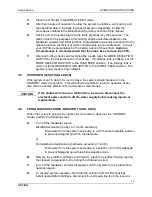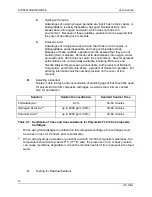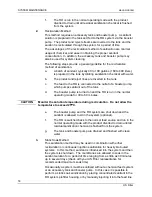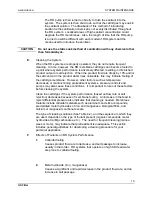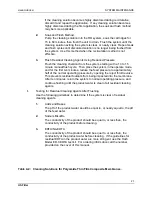
MANOWNROSM
TROUBLESHOOTING
US Filter
27
5. 0
TROUBLESHOOTING
5.1
SYSTEM INOPERATIVE
A.
Check to see if power is available to the unit and turned on.
B.
Check to see that the motor starter relay is engaging, and if the control lights
come on but the pump does not start. With an ohm meter, check to see if the
motor starter coil is burned out. Reset the overload relay to determine if an
overload condition has caused the relay to disengage.
C.
With a voltmeter check that power is being supplied to the motor. If proper
voltage is going to the motor but it does not run, call US Filter Technical Support.
D.
Check for proper function of the controller circuit board. Replace if necessary.
5.2
LOW SYSTEM PRESSURE
A.
Verify the pump is running and the system is not in the flush mode.
B.
If pressure is low at system startup, stop system immediately and verify pump
rotation is clockwise.
CAUTION
Do not run pump backwards for more than 30 seconds or irreversible
damage will result.
C.
Check to verify that the reject, reject recirculation, and product flows are normal.
If not, adjust to design flow rates using the System Specifications sheet in the
Appendix.
D.
If the flows cannot be adjusted to the desired flow rates, slowly close the pump
discharge throttle valve to observe the maximum discharge pressure. Do this
only briefly and do not completely close the valve. The pressure should be
greater than 27.6 bar (400 psig).
E.
If pump pressure is okay, check prefilters for plugging/high differential pressure.
F.
If the pump pressure is too low, repair or replace the pump. Check the
pump/motor coupling to be sure it is not slipping on the pump or the motor shaft.
5.3
LOW PERCENT RECOVERY
A.
Check reject flows and pressures to be sure they are normal.
B.
If feed to membrane pressure equals system maximum and the permeate flow is
low, the RO membranes are beginning to fail. They should be cleaned or
replaced.
5.4
HIGH PERCENT RECOVERY
A.
Check pressures and flows.
B.
Set the reject pressure to 13.8 bar (200 psig).

